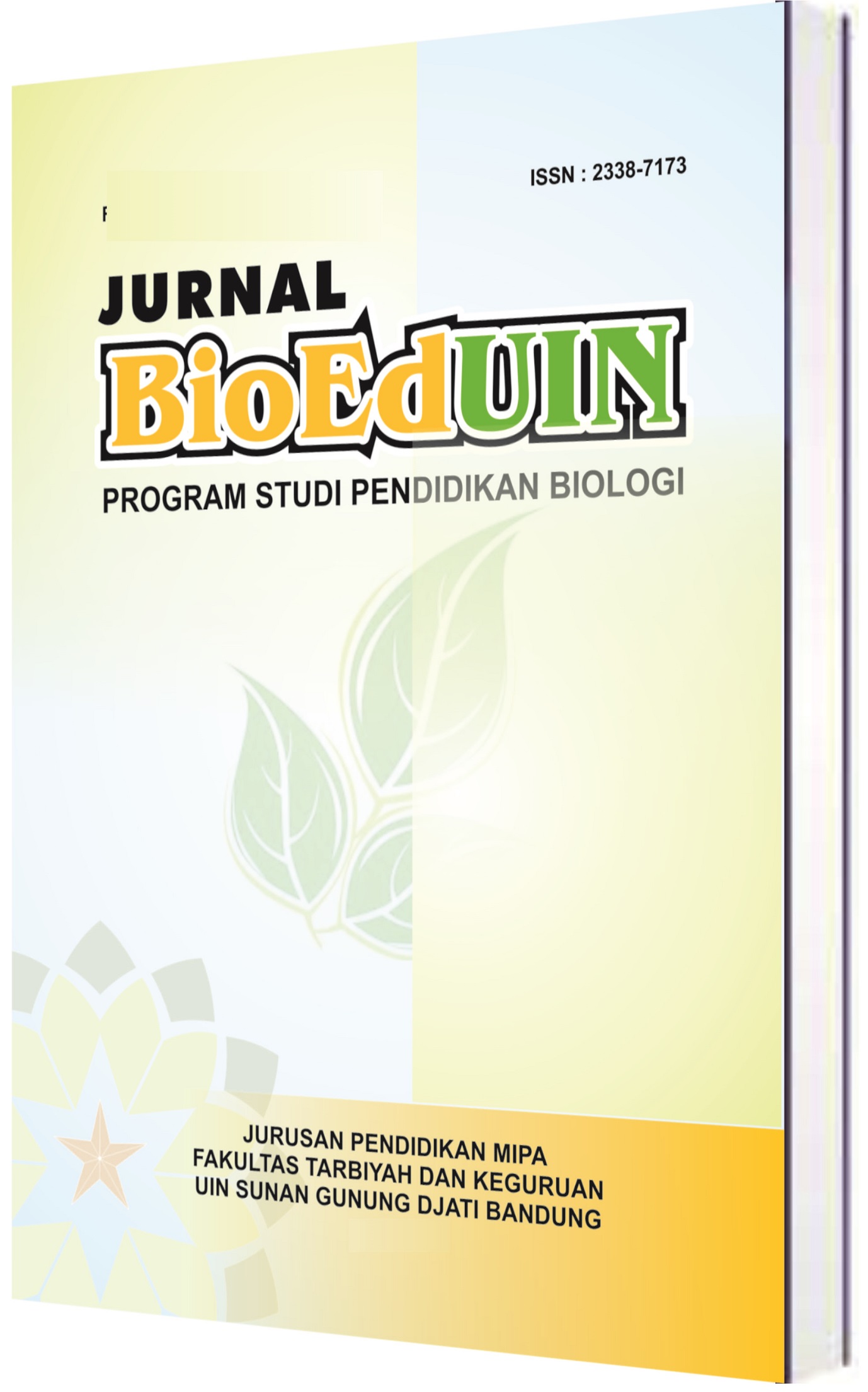ANALISIS KEMAMPUAN LITERASI SAINS SISWA SMA PADA PEMBELAJARAN BIOLOGI MENGGUNAKAN NOSLiT
DOI:
https://doi.org/10.15575/bioeduin.v10i1.8141Keywords:
Literasi sains, NOSLiT, BiologiLiterasi sains, BiologiAbstract
Keywords: Scientific literacy, NOSLiT, Biology
Abstrak. Tujuan dari penelitian ini adalah untuk menganalisis pencapaian keterampilan literasi sains siswa sekolah menengah atas berdasarkan hasil pengukuran menggunakan Nature of Science Literacy Test (NOSLiT). Instrumen yang digunakan diadaptasi dan dimodifikasi sesuai dengan budaya Indonesia. Penulis menggunakan metode penelitian deskriptif. Penelitian dilakukan dengan mengambil sampel secara acak kepada siswa sekolah menengah atas kelas XI di Kota Surakarta. Hasil penelitian menunjukkan bahwa keterampilan literasi siswa dikategorikan rendah dengan rata-rata pencapaian 40,5%. Hasil yang didapatkan sesuai dengan kemampuan siswa dalam menganalisis, membangun konsep, dan cara menyelesaikan masalah yang terdapat dalam soal. Untuk meningkatkan kemampuan literasi siswa pada konten biologi perlu adanya metode belajar yang lebih efektif dan meningkatkan rasa ingin tahu siswa.
References
Ariyanti, A. I. P., Ramli, M., & Prayitno, B. A. (2016). Preliminary Study on Developing Science Literacy Test for High School Students in Indonesia. Proceeding of International Conference on Teacher Training and Education, 1(1), 284–289. Retrieved from http://jurnal.fkip.uns.ac.id/index.php/ictte/article/view/7604
Boujaoude, S. (2002). Balance of scientific literacy themes in science curricula. International Journal of Science Education, 24(2), 139-156.
Fakhriyah, F., Masfuah, S., Roysa, M., Rusilowati, A., & Rahayu, E. S. (2017). STUDENT’S SCIENCE LITERACY IN THE ASPECT OF CONTENT SCIENCE. Jurnal Pendidikan IPA Indonesia, 6(1), 81-87.
Imani , Hajar Adha, Ika Mustika Sari, P. (2016). Profil Literasi Siswa SMP di Kota Bandung Terkait Tema Pemanasan Global (pp. 242–248). pp. 242–248.
Muhammad, S. N., Adhani, A., & Listiani. (2018). Hubungan Antara Literasi Sains Dan Rasa Ingin Tahu Siswa Pada Materi Ekosistem Di Sma Negeri 3 Tarakan ( Correlation Between Science Literacy and Student Curiosity on Ecosistem Topic At Sma Negeri 3 Tarakan ). Natural: Jurnal Ilmiah Pendidikan Ipa, 5(2), 112–116.
Murti, P. R., Aminah, N. S., & Harjana. (2018). The Analysis of High School Students’ Science Literacy Based on Nature of Science Literacy Test (NOSLiT). Journal of Physics: Conference Series, 1097(1). https://doi.org/10.1088/1742-6596/1097/1/012003
OECD. (2019). PISA 2018 - Insight and Interpretations. Paris: OECD Publishing.
Pella, M. O., & Gale, C. W. (1966). Scientific literacy-its referents. The Science Teacher, 33(5).
Pustitasari, Mydha T., Sigit Santoso, B. M. (2019). Upaya Meningkatkan Karakter Rasa Ingin Tahu dan Hasil Belajar Akuntansi Melalui Pembelajaran Kontekstual Dengan Metode Snowball Throwing Pada Siswa SMK Muhammadiyah 3 Gemolong. Journal of Chemical Information and Modeling, 53(9), 1689–1699. https://doi.org/10.1017/CBO9781107415324.004
Rokhmah, A., Sunarno, W., & Masykuri, M. (2017). Science Literacy Indicators in Optical Instruments of Highschool Physics Textbooks Chapter. Jurnal Pendidikan Fisika Indonesia, 13(1), 19–24. https://doi.org/10.15294/jpfi.v13i1.8391
Suwono,H.,Rizkita,L. & Susilo, H. (2017). Peningkatan Literasi Saintifik Siswa SMA Melalui Pembelajaran Biologi Berbasis Masalah. Jurnal Ilmu Pendidikan ,21(2).136-144
Wenning, C. J. (2011). Experimental Inquiry in Introductory Physics Courses. Journal of Physics Teacher Education Online, 6(2), 2–8.
Wenning. (2006). A framework for teaching the nature of science. J. Phys. Tchr. Educ. Online, 3(3), 3–10.
Wenning, C.J. &Wenning, R.E. (2006).Assessing Nature-Of-Science Literacy as One Component of Scientific Literacy. Journal of Physics Teacher Education Online, 3(4),3-14
Wenning, C. J. (2005). Levels of inquiry: Hierarchies of pedagogical practices and inquiry processes. Journal of Physics Teacher Education Online, 2(3), 3–11. Retrieved from http://scholar.google.com/scholar?hl=en&btnG=Search&q=intitle:Levels+of+inquiry:+Hierarchies+of+pedagogical+practices+and+inquiry+processes#
Wijaya, E. Y., Sudjimat, D. A., Nyoto, A., & Malang, U. N. (2016). Transformasi Pendidikan Abad 21 Sebagai Tuntutan Pengembangan Sumber Daya Manusia di Era Global. In Prosiding Seminar Nasional Pendidikan Matematika. Vol. 1 (26).
Downloads
Published
How to Cite
Issue
Section
Citation Check
License
Authors who publish in Jurnal BIOEDUIN agree to the following terms:
- Authors retain copyright and grant the journal right of first publication with the work simultaneously licensed under a Attribution-ShareAlike 4.0 International (CC BY-SA 4.0) License that allows others to share the work with an acknowledgment of the work's authorship and initial publication in this journal.
- Authors are able to enter into separate, additional contractual arrangements for the non-exclusive distribution of the journal's published version of the work (e.g., post it to an institutional repository or publish it in a book), with an acknowledgment of its initial publication in this journal.
- Authors are permitted and encouraged to post their work online (e.g., in institutional repositories or on their website) prior to and during the submission process, as it can lead to productive exchanges, as well as earlier and greater citation of published work (See The Effect of Open Access).






